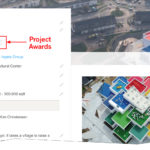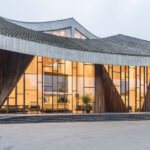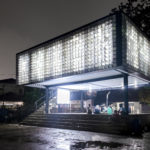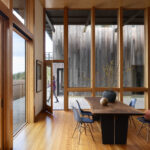Perhaps more than any other capital city in the world, Beijing is characterized by its mix of historic typologies, new buildings, and the seemingly constant crush of construction throughout the city. While it is unfortunate that most of the new projects are as anonymous as their predecessors and neighbors, last month saw the opening of a notable new project: the Minsheng Contemporary Art Museum by local firm Studio Pei-Zhu.

Formerly a Panasonic factory, the 35,000-square-foot museum marks an important addition to the city’s 798 Arts District where Beijing’s art community had first started settling into the abandoned factories, relics of the mid-20th century, at the turn of the millennium. Even with the creeping commercialization of the district in recent years, 798 remains an important destination for both collectors and tourists alike, not to mention the artists and designers themselves.
Located just north of the gallery district itself, the Minsheng Contemporary Art Museum represents a felicitous hybrid of bottom-up and top-down interests: billed as the largest public exhibition space for Chinese contemporary art, the institution takes its name from its underwriter, the China Minsheng Bank, which footed the 200-million-RMB ($32-million) price tag. (The Beijing museum joins two others, in Shanghai, that bear the Minsheng name; the more recent of the two actually occupies the French pavilion from the 2010 World Expo.)
“The factory was built around 1979; it was the first overseas-funded enterprise factory that has been built in China after [the] Cultural Revolution,” principal and founder Zhu Pei relates. “The challenge for me was to take advantage from the simplicity and true of existing structure to create a flexible contemporary art museum. ‘Use of uselessness’ is the concept for this project.”

© Studio Zhu Pei
Insofar as the structure of the building remains intact, the architect has effectively redistributed the interior space into galleries of different sizes to accommodate a variety of media including a black box performance space; the atrium sees the expansion of the ceiling of the two double-height stories into a canted, quilted box of an entryway. Given such a generic building form, Zhu notes that he wanted “to create a tension point, which can stimulate the existing dead building and give a clear sense to people how to approach and travel inside of this building.”
Zhu has largely made his name with galleries, museums, and cultural spaces in major cities throughout China — in addition to built projects in Dali, Ningbo, and Shenzhen, he has been invited to design concepts for the Guggenheim in Beijing and Abu Dhabi — as well as from working with major artists like Yue Minjun and Cai Guoqiang on a dedicated art museum and a courtyard house renovation, respectively.

© Studio Zhu Pei
In fact, one of Studio Pei-Zhu’s best known projects is another conversion, also of a factory into a contemporary art space: Pace Gallery, in the northern part of the 798 Arts District proper, is just a short walk from the new Minsheng Contemporary Art Museum, yet the project is strikingly different both in concept and execution.
“There is a very different character between those two existing buildings,” Zhu notes. “[Pace as a] 50s factory has a very strong style with beautiful arch and skylight, which makes it a natural fit for a contemporary art museum. The Panasonic factory was so generic that it is hard to [accommodate the program].” Thus, Zhu has elected to make more of a statement by punctuating the existing building with a vertical extension clad in a veritable quilt of aluminum tiles to evoke a more restrained version of Gehry or Libeskind. “One day, when I stopped by the construction site to take a walk, I was attracted by the material that some workers were using for an air duct — it softly catches the light of sunset, yet it is so ordinary and cheap that architects have never paid attention to it.“

© Studio Zhu Pei
The understated embellishment suits the long, narrow building nicely, and the architect notes that response has been good so far. “The most important moment for architecture is not the completion of the building, but when the spaces intersect with people.”









